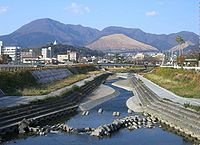
Photo from wikipedia
New U–Pb ages of zircons from migmatitic pelitic gneisses in the Omuta district, northern Kyushu, southwest Japan are presented. Metamorphic zonation from the Suo metamorphic complex to the gneisses suggests… Click to show full abstract
New U–Pb ages of zircons from migmatitic pelitic gneisses in the Omuta district, northern Kyushu, southwest Japan are presented. Metamorphic zonation from the Suo metamorphic complex to the gneisses suggests that the protolith of the gneisses was the Suo metamorphic complex. The zircon ages reveal the following: (i) a transformation took place from the high-P Suo metamorphic complex to a high-T metamorphic complex that includes the migmatitic pelitic gneisses; (ii) the detrital zircon cores in the Suo pelitic rocks have two main age components (ca 1900–1800 Ma and 250 Ma), with some of the detrital zircon cores being supplied (being reworked) from a high-grade metamorphic source; and (iii) one metamorphic zircon rim yields 105.1 ±5.3 Ma concordant age that represents the age of the high-T metamorphism. The high-P to high-T transformation of metamorphic complexes implies the seaward shift of a volcanic arc or a landward shift of the metamorphic complex from a trench to the sides of a volcanic arc in an arc–trench system during the Early Cretaceous. The Omuta district is located on the same geographical trend as the Ryoke plutono-metamorphic complex, and our estimated age of the high-T metamorphism is similar to that of the Ryoke plutono-metamorphism in the Yanai district of western Chugoku. Therefore, the high-T metamorphic complex possibly represents the western extension of the Ryoke plutono-metamorphic complex. The protolith of the metamorphic rocks of the Ryoke plutono-metamorphic complex was the Jurassic accretionary complex of the inner zone of southwest Japan. The high-P to high-T transformation in the Omuta district also suggests that the geographic trend of the Jurassic accretionary complex was oblique to that of the mid-Cretaceous high-T metamorphic field.
Journal Title: Island Arc
Year Published: 2017
Link to full text (if available)
Share on Social Media: Sign Up to like & get
recommendations!